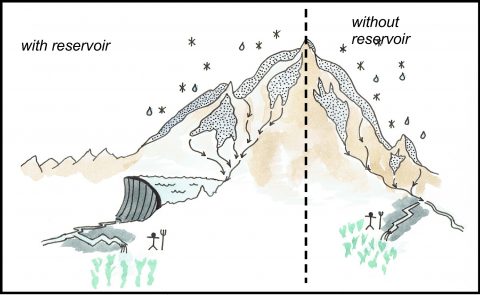The fall colors are moving from the trees to the sidewalk, and the morning walk to the bus stop seems colder each day. “Do you think it will snow today?” my son asks each morning. “I want it to snow!” We live in Seattle and, if we’re lucky, we will get snow on one day in December or January.
But the desire for snow is widespread. The late-December winter break typically contributes 15 to 30 percent of skier visitation. According to Elizabeth Burakowski from the University of New Hampshire, summarizing data in a 2018 report she co-authored for the non-profit, Protect Our Winters, the US ski industry “generates over $11 billion in economic activity and supports nearly 200,000 jobs in the US.” The report goes on to state, “In low snow years, reduced skier visitation at US resorts decreased economic activity by over $1 billion and cost 17,400 jobs compared to average snow seasons over the period 2001 to 2016.”
Water and life from snow: A trillion dollar science question was a commentary by Matthew Sturm, Michael Goldstein and Charles Parr published in Water Resources Research in 2017.

They included potential uncertainties in the rate at which snow disappears and the “discount rate”, which measures how rapidly the value of an item in the future decreases as compared to how people value it today – its depreciation, in other words.
They assumed that two-thirds of snowmelt runoff are captured and used, while one-third is lost due to run off to the ocean or loss to the atmosphere. Dollar amounts are based on a conservative estimate that, over a specified period of time, one half of all current snowfall will come as rain. Therefore, one-third of the current snowpack can be considered lost revenue.
The takeaway was well-stated by Goldstein when he appeared on New England Cable News. Assuming that two-thirds of the snowpack are economically valuable and 50 percent of that snowpack disappears, the total present value of the lost usable snow in the western United States, (“estimating a water cost of $900 per acre foot, the value of water during the drought”) would be “$4.7 trillion, more money than the federal government takes in from all taxes in a year.”
For the western United States, specific values of Sturm et al.’s calculations became more useful when coupled with model simulations presented in Geophysical Research Letters by Li et al. [2017], which determined how much streamflow comes from snow in each basin in the western United States.
The results of both of these papers have been combined into an online interactive map that shows the average volume of runoff in each basin. Tools represented with dollar signs allow users to change various economic assumptions and quickly calculate the present value of a lost snow resource as a function of the present-day cost of water, the number of years until one-third of the current snow water runoff becomes a lost resource, the number of years projected into the future, and the discount rate.

—Jessica D. Lundquist (email: jdlund@uw.edu), Editor, Water Resources Research, and Department of Civil and Environmental Engineering, University of Washington
